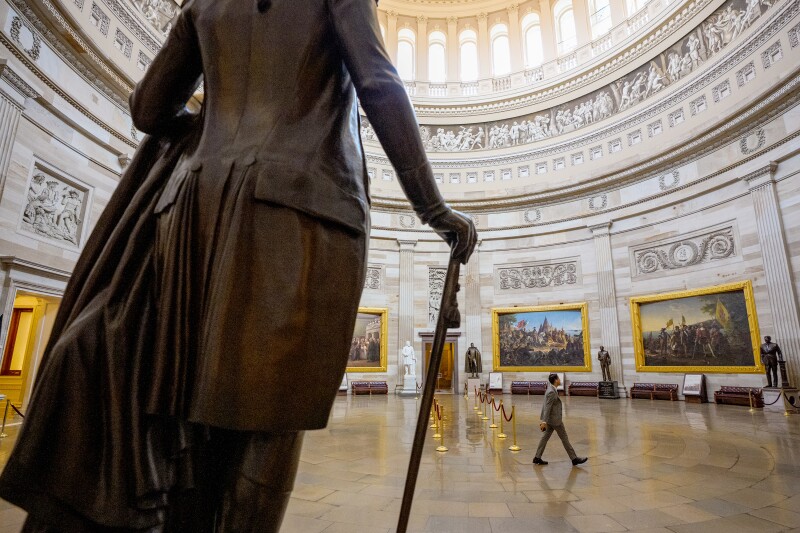Politics
U.S. Fiscal Crisis Deepens as Borrowing Surges to $1.8 Trillion

The U.S. Treasury Department has reported alarming fiscal data for the fiscal year 2025, revealing that the government spent over $7 trillion while collecting only $5.2 trillion in taxes. This left a staggering deficit of $1.8 trillion, representing more than a quarter of public spending and approximately 6% of the nation’s gross domestic product (GDP). The implications of this fiscal imbalance are severe, with economists warning that the situation is becoming increasingly unsustainable.
While Washington focuses on immediate political issues, such as the potential for government shutdowns, it is neglecting a looming fiscal crisis that could have far-reaching consequences. The Congressional Budget Office (CBO) has projected that if current laws remain unchanged, the ratio of federal debt to GDP, already at a postwar high of roughly 100%, is expected to exceed 150% in the coming decades. Should interest rates increase more than anticipated—by as little as 5 basis points annually—the debt ratio could surpass 200%. Furthermore, if revenues and spending revert to historical averages, the debt ratio could climb to over 225% by 2050, and even further by 2055.
Warnings are mounting as three major federal trust funds approach insolvency. The Highway Trust Fund, which is primarily funded by gasoline taxes, is expected to be depleted by 2028. Meanwhile, both the Social Security retirement fund and the Medicare hospital insurance fund are projected to run out by 2032. If these funds are exhausted, mandatory budget cuts will ensue, including a 46% reduction in highway spending, a 24% cut to Social Security payments, and a 12% reduction in Medicare payments.
Historically, Congress has tended to bypass such fiscal constraints, allowing national debt to continue rising. This behavior raises concerns among lenders, who may subsequently demand higher interest rates to mitigate perceived repayment risks. The pressure on future interest rates is compounded by demographic changes, such as an increasing ratio of dependents to workers, alongside the need for additional investments in defense and clean energy initiatives.
Addressing the deficit is no simple task. Stabilizing the debt at its current level of 100% of GDP would require significant measures, including reducing the deficit from $1.8 trillion to approximately $1.3 trillion. This would necessitate tax increases and/or spending cuts amounting to around $500 billion annually, equivalent to a 10% increase in taxes across the board. Merely stabilizing the debt is insufficient, as it leaves no margin for maneuvering during economic downturns or other emergencies.
Each year that passes without decisive action to rectify this fiscal imbalance makes solutions increasingly difficult to implement. It is crucial for the White House and Congress to acknowledge the severity of the situation and to engage in serious discussions about a balanced approach that includes both spending restraints and increased revenues. Even a minimal consideration of this pressing issue would mark a significant step forward in addressing the impending fiscal crisis.
This analysis underscores the urgent need for comprehensive reform to ensure fiscal sustainability and economic stability in the years to come.
-

 Science3 weeks ago
Science3 weeks agoInterstellar Object 3I/ATLAS Emits Unique Metal Alloy, Says Scientist
-

 Politics3 weeks ago
Politics3 weeks agoAfghan Refugee Detained by ICE After Asylum Hearing in New York
-

 Business3 weeks ago
Business3 weeks agoIconic Sand Dollar Social Club Listed for $3 Million in Folly Beach
-

 Health3 weeks ago
Health3 weeks agoPeptilogics Secures $78 Million to Combat Prosthetic Joint Infections
-

 Science3 weeks ago
Science3 weeks agoResearchers Achieve Fastest Genome Sequencing in Under Four Hours
-

 Lifestyle3 weeks ago
Lifestyle3 weeks agoJump for Good: San Clemente Pier Fundraiser Allows Legal Leaps
-

 Science3 weeks ago
Science3 weeks agoMars Observed: Detailed Imaging Reveals Dust Avalanche Dynamics
-

 Health3 weeks ago
Health3 weeks agoResearcher Uncovers Zika Virus Pathway to Placenta Using Nanotubes
-

 World3 weeks ago
World3 weeks agoUS Passport Ranks Drop Out of Top 10 for First Time Ever
-

 Entertainment3 weeks ago
Entertainment3 weeks agoJennifer Lopez Addresses A-Rod Split in Candid Interview
-

 Business3 weeks ago
Business3 weeks agoSan Jose High-Rise Faces Foreclosure Over $182.5 Million Loan
-

 Top Stories3 weeks ago
Top Stories3 weeks agoChicago Symphony Orchestra Dazzles with Berlioz Under Mäkelä








